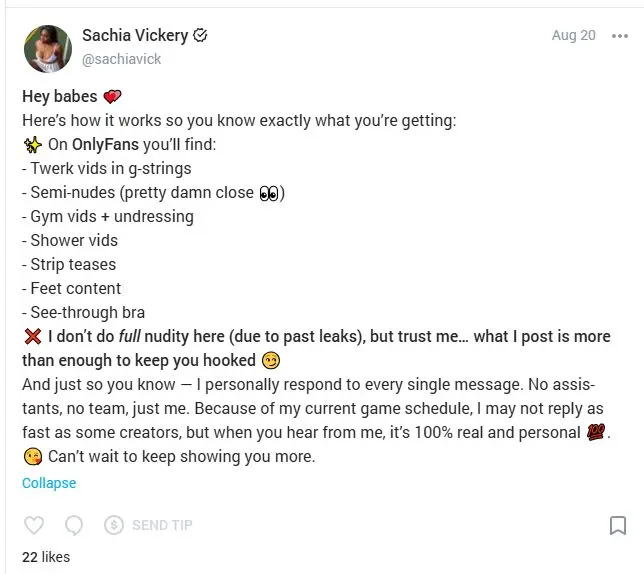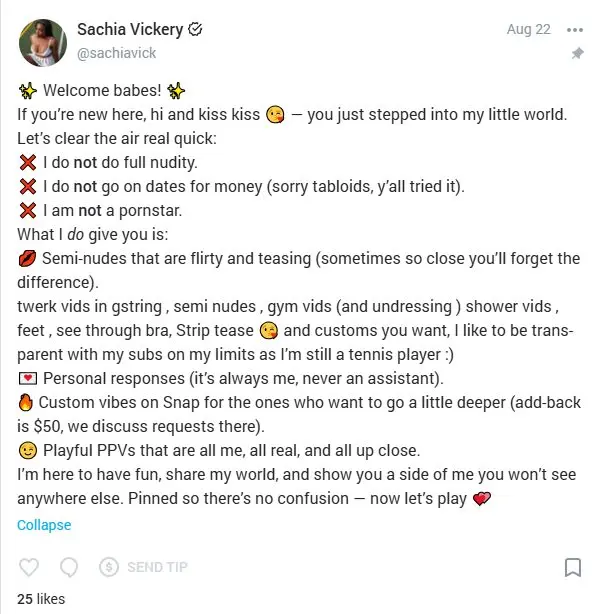When American tennis player Sachia Vickery walked onto the courts in Flushing for the U.S. Open qualifiers this week, she carried more than her racket bag. She also carried the scrutiny that comes with being one of a growing number of professional athletes supplementing their careers through OnlyFans.
The 30-year-old, ranked outside the world’s top 500, launched her account in January, charging $12.99 a month for workout videos, lingerie photos, and what she calls “spicy” behind-the-scenes content. She insists she does not post nudity or explicit sex, but admits the financial boost has been transformative.
“I’m very open-minded and I don’t care what people think of me,” Vickery said. “It’s the easiest money I’ve ever made, and I enjoy doing it.”
Within her first three months, she hit six figures in earnings, more than she has made in some seasons of professional tennis. For Sachia Vickery, who has career prize money of $2.1 million but says yearly expenses can top $100,000, the platform has become a financial lifeline.
Professional tennis is a sport of sharp financial contrasts. While stars like Novak Djokovic and Coco Gauff command millions in endorsements, players outside the top 100 often face steep costs and limited sponsorships.
“It’s given me financial freedom,” Vickery said. “Even helping me fund my entire tennis career.”
Her message echoes athletes in other sports where paychecks are modest and careers uncertain.
Sachia Vickery is not alone. OnlyFans, founded in 2016, has become an unlikely side hustle for athletes across disciplines:
In tennis, Nick Kyrgios launched content on the platform in 2023, French player Alexandre Müller posts lifestyle material, and Australian pro Arina Rodionova joined this year, explicitly stating she would not post nudes.
The common thread: athletes outside the very top ranks are leveraging their visibility to bridge financial gaps left by prize money and sponsorship shortfalls.
While top tennis stars earn millions in prize money and endorsements, the vast majority of players operate on slim margins.
The Women’s Tennis Association (WTA) has pledged to equalize prize money at major events by 2033 and has increased its total prize pool to $249 million for 2025, but critics say progress is too slow to address the financial pressures players like Vickery face today.
For many athletes, joining OnlyFans carries stigma. Tabloids branded Sachia Vickery a sex worker, and critics accused her of tarnishing tennis. She pushed back.
“I have no sexual content on there,” she said. “I have lingerie content, I push boundaries, but I’ve never done sex videos. People don’t understand there are levels to OnlyFans.”
She also dismissed viral headlines claiming she needed a $1,000 deposit to date her, calling it a joke.
The story of Sachia's OnlyFans has taken a life of its own. So much so, she's had to make a statement clarifying what she offers on her page. Originally, she had said ...

But two days later, I had to change that offering and clarify what she meant.

For Sachia Vickery, the real conversation is about player support. “If you don’t want players on OnlyFans, why don’t we set up a system where you actually pay players outside of the top 100 what we deserve?”
The Women’s Tennis Association has pledged equal prize money at all major events by 2033, and the overall prize pool will reach a record $249 million in 2025. But players like Vickery argue progress is too slow for those competing now.
Her case highlights a tension felt across sports: in an era where athletes are expected to be both competitors and brands, platforms like OnlyFans offer an immediate — if controversial — solution.
“I’ve always been outspoken,” Vickery said. “I’m still playing tennis, but I also want to do things outside of tennis. For me, it’s not a big deal.”
For some, it’s survival. For others, it’s empowerment. Either way, the trend suggests that OnlyFans is no longer just an online curiosity; it is becoming part of the modern athlete’s playbook.